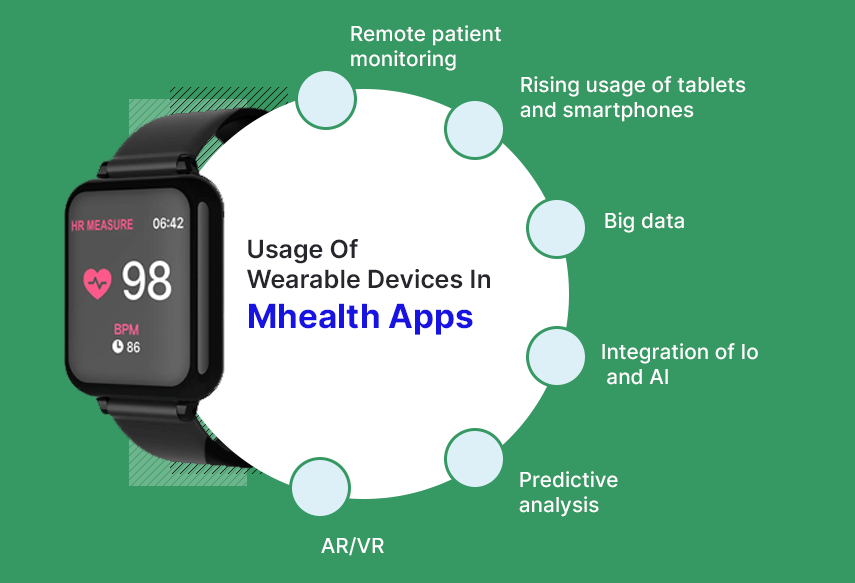Owing to the rising demand by the consumers to keep track of their personal health, the mHealth industry is witnessing a substantial rise in wearable devices. These devices, embedded with the latest technology, initially designed keeping the user convenience in mind are now in the constant upgrade and development phase to launch newer innovations in the market. The mHealth wearable devices are not just a boon to the patients using them, but it is also a ray of hope for the doctors and other healthcare professionals as well.
These devices are connected with the app that is installed in the smart devices, majorly on mobile phones. One of the major factors fueling the demand for wearable devices is the adoption of mHealth technology by healthcare providers, hospitals, insurers, app development firms, etc. Basically, healthcare apps are now turning into a significant part of core health IT functions.
Some Of The Key Trends Piloting The Usage Of Wearable Devices In mHealth Apps Are:

1 Remote Patient Monitoring
The remote patient monitoring devices keep a check on the patient and send the data to the healthcare provider through an electronic medium. The data monitors the sleeping pattern, heart rate, physical activities like steps taken, etc. Apart from this, it also captures glucose reading, blood test results, and medical images.
2 Rising Usage Of Tablets And Smartphones
Tablets and smartphones are among the most used devices across the world. The mHealth app development companies are leveraging this rise for their growth. A major section of the doctors is using mobile phones to stay connected with their patients and monitor their health progress and current status. Many app development firms are working on healthcare apps that would be accessible by patients and doctors. They also help in keeping transparency between the two parties and get easy access to the current and past health records.
3 Big Data
The growth in mobile technologies, which has boosted the use of mHealth apps and devices produces a lot of user data, which is known as big-data. Though already used for EHR, there are various mobile healthcare sectors that are likely to be beneficial from big data. Some of the benefits of big data are:
- Reduced hospital fees
- Better reactive care and preventive care
- Enhanced quality of life
- Lesser wait time
- Improved personalized treatment
- Better security
4 Integration Of IoT And AI
Artificial intelligence and Internet of Things are among the leading technologies in the market. IoT devices contribute to locating the physicians or doctors around the patient in times of emergency. This helps in providing the treatment to the patient on time and saves both the parties from future hassle and discomfort. An example of the implementation of IoT is the usage of glucose monitors as wearable. These wearables are connected with the inhalers that makes it simpler for the doctor to diagnose the patient and treat him with accuracy.
Similarly, AI aids the devices to learn, respond, sense, and comprehend in a way that it can perform various administrative and medical healthcare functions. Some of the mHealth wearable applications of artificial intelligence are:
- Virtual nursing assistants
- Dosage error reduction
- Preliminary diagnosis
- Cybersecurity of mHealth apps
5 AR/VR
Now, the patients can watch the virtual reality clips to combat the trauma, much more comfortably than before. This also prevents them from being in an actual unsafe environment. Several healthcare firms are working on developing platforms that enable healthcare providers to design augmented reality and virtual reality programs. These programs, integrated with wearable devices aim to provide patient care management facilities at the hospital or at the patient’s doorstep.
6 Predictive Analysis
Predictive analysis has been very helpful in personalized care. And currently, the technology is also being used for various other mHealth apps and medicine ecosystems. Predictive analysis is currently estimated to be used for:
- Geo-mapping
- Risk estimation
- What-if cases
Implementation and usage of predictive analysis at the right time would help in preventing patient health deterioration, saving patients from self-harm, readmission of patients after 30 days, lesser no shows at the time of appointments, and so on.
Effect Of mHealth Wearables On Healthcare Sector And Healthcare Professionals?
Wearable technology alone, when launched, did not gain much attention from the people. However, when combined with mobile healthcare technology, it grabbed the eyeballs of the patients as well as the stakeholders. One such example of this change is the adoption of Google Glass vs. Fitness Tracker. Clearly, the sale of fitness trackers is more than those of Google Glasses. Also, the professionals working in healthcare sectors and the patients, both are increasingly adopting wearable technology to simplify their lives.
With the increased number of smartphone users, the number of people utilizing mHealth apps is also increasing since a while. Earlier, these mHealth apps were limited in their functionalities. But today with the advancement in technology, these apps along with the wearable devices can keep a check and give information about many health aspects such as blood pressure, heart rate, respiratory functions, etc. mHealth wearables are not limited to only fitness bands, but also help healthcare professionals to carry out various complex medical procedures and issues.
Let Us Have A Look At How mHealth Wearables Help Healthcare Professionals:
Health wearables are transforming the diagnosis and treatment methods in the healthcare industry. Surgeons can now efficiently carry out the surgery using mHealth wearables. Even the most complicated surgeries also can be conducted with much ease and accuracy after the emergence of wearables.
Earlier, the surgical processes were complicated, tedious, and highly invasive that often resulted in a lot of blood loss and complications. However, because of mHealth wearables, the trend of minimally-invasive surgeries is picking pace. This method does not only reduce the complications, but also lessens the blood loss, chances of infection after surgery, and extended hospital stay. It also means shorter recovery time. The robotic wearable arm is one such example of mHealth wearable technology that is making the healthcare procedure smooth and hassle-free.

Types Of Wearable Devices In mHealth
Wearable health devices have become a part of daily lives among the people, especially in urban areas due to better internet connectivity and awareness among the population. Among the most common measures of wearable devices are blood oxygen saturation, heart rate, body temperature, physical activities, BCG, ECG, and postures. These wearables can be worn on the body or attached to the skin, clothes, etc. in the form of a patch, chip, watch, bands and so on. Some of the widely accepted wearables in the mHealth industry are:
Fitness Trackers
Fitness trackers are the most common form of wearable devices in the market. The fitness band has sensors embedded in it that give the information about the heart rate, physical activities like the number of steps in a day, a reminder to drink water, etc. Many companies are launching their brand of fitness bands/trackers which is also contributing notably in improving the market status of mHealth wearable devices.
Wearable ECG Monitors
A wearable ECG monitor is a new addition in the range of consumer electronics. The ability of these ECG monitors is to read the heart signals in the form of an electrocardiograph. The readings from these devices are sent to the doctor to keep a track of the patient's heart health. One of the wearable ECG monitors, Move ECG was awarded as the best consumer electronic product in 2019.
Smart Health Watch
These watches were initially designed to display time and count steps. But, with gradual updates, these watches now have advanced features embedded in it. Apple recently launched Movement Disorder API that helps researchers to monitor the new developments in Parkinson’s disease. These smartwatches display the incoming messages, calls, allowing the wearer to read the notifications, send messages, etc. including some of the features of fitness trackers as well.
Wearable BP Monitors
The first wearable blood pressure monitor was launched in 2019 by Omron healthcare. This BP monitor is an oscillometric BP monitor that measures daily activities such as distance traveled, steps taken, calories burned, and blood pressure. The device can store 100 readings in its memory that can be easily transferred to a mobile app for future comparisons and treatment options.
Future Scope
Biosensors
One of the most recent innovations in the wearable device industry is biosensors. They are distinctly different from smartwatch and fitness bands. The biosensors are conceptualized to be a self-sticking patch which will enable patients to carry their daily tasks at the same pace, while the biosensors would keep a record and monitor the heart rate, temperature, physical movement, and respiratory rate. The device is estimated to reduce around 89% of patient deterioration into respiratory attacks or cardiac arrests.
Body-worn Smart Clothing
Another potential innovation in the mHealth wearable technology is body-worn smart clothing. This innovation requires mobile applications, big data, machine learning, and cloud computing. The current health monitoring devices that are used to log a limited number of physiological signals in the form of digital data are not very effective for chronic ailments. In the case of long term health monitoring, the healthcare sector is in need of something more efficient and precise, along with a device that would have larger memory and advanced machine learning ability, integrated with artificial intelligence.
The main difference between regular wearable devices and body-worn smart clothing is the placement of sensors or sensor deployment. In smart clothing, all sensors that are needed to track the vitals of the patients require accurate integration with textile clothing. In order to achieve a proper design, the positioning of sensors, quality of sensors, electric cables, signal catching devices, and user comfort are some of the major aspects to take care of. More comfortable the fabric of smart clothing is, more effective are its results as the wearer will not have to adjust the clothing repeatedly to fit his body structure.
Wrapping up,
With the surging demand for mHealth wearable devices, an increasing number of app development and IT firms are showing interest in it. Besides, several insurance companies are also re-modeling their policies owing to the advancement in technology and increased life expectancy because of it. Wearable devices are foreseen to reduce hospital visits and provide instant care on a primary level. This, in turn, would reduce the overall healthcare expenses of the people. It won’t be wrong to say that the results of wearable would improve with the new innovations that would provide more accurate metrics in an even shorter time span. And this possibility keeps the scope of opportunities open for mobile app development firms, IT companies, and insurance providers.





 May 4, 2020
May 4, 2020


